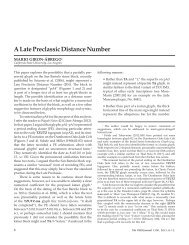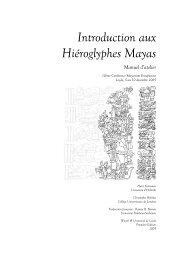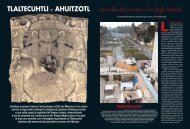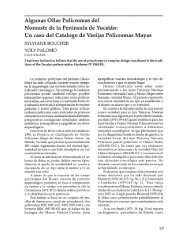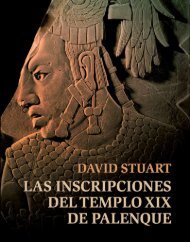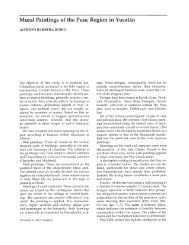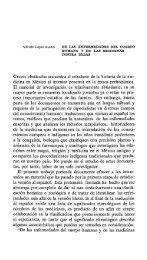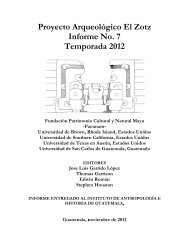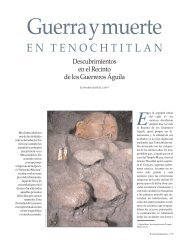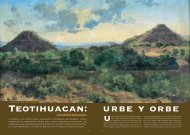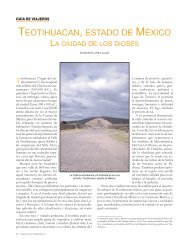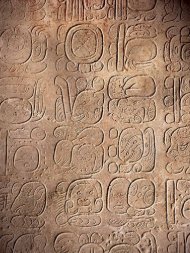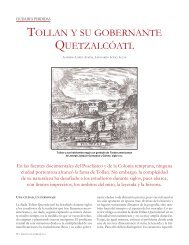Popol Vuh: Sacred Book of the Quiché Maya - Mesoweb
Popol Vuh: Sacred Book of the Quiché Maya - Mesoweb
Popol Vuh: Sacred Book of the Quiché Maya - Mesoweb
You also want an ePaper? Increase the reach of your titles
YUMPU automatically turns print PDFs into web optimized ePapers that Google loves.
years prior to <strong>the</strong> Spanish conquest, <strong>the</strong> <strong>Maya</strong> developed a sophisticated hieroglyphic script<br />
capable <strong>of</strong> recording complex literary compositions, both on folded screen codices made <strong>of</strong><br />
bark paper as well as texts incised on more durable stone or wood. The importance <strong>of</strong><br />
preserving written records was a hallmark <strong>of</strong> <strong>Maya</strong> culture as witnessed by <strong>the</strong> thousands <strong>of</strong><br />
known hieroglyphic inscriptions, many more <strong>of</strong> which are still being discovered in <strong>the</strong> jungles<br />
<strong>of</strong> sou<strong>the</strong>rn Mexico and nor<strong>the</strong>rn Central America.<br />
Being a phonetic script ra<strong>the</strong>r than a pictorial form <strong>of</strong> writing, <strong>Maya</strong> hieroglyphs were<br />
capable <strong>of</strong> recording any idea that could be spoken. Ancient <strong>Maya</strong> scribes were among <strong>the</strong><br />
most honored members <strong>of</strong> creative society. They were <strong>of</strong>ten important representatives <strong>of</strong> <strong>the</strong><br />
royal family, and as such were believed to carry <strong>the</strong> seeds <strong>of</strong> divinity within <strong>the</strong>ir blood.<br />
Among <strong>the</strong> titles given to artists and scribes in Classic period <strong>Maya</strong> inscriptions were itz’aat<br />
(“sage”) and miyaatz (“wise one”). In an important royal tomb at Tikal (Burial 116), an<br />
incised bone depicts a deified scribe’s hand emerging from <strong>the</strong> gullet <strong>of</strong> an open-mou<strong>the</strong>d<br />
creature. In Classic <strong>Maya</strong> art, <strong>the</strong> open jaws represent a portal that leads from this world to<br />
<strong>the</strong> world <strong>of</strong> <strong>the</strong> gods. In his or her hand is a calligraphic paintbrush used to both write and<br />
illustrate <strong>the</strong> ancient <strong>Maya</strong> codex books. The message <strong>of</strong> this incised bone is that <strong>the</strong><br />
activities <strong>of</strong> <strong>the</strong> scribe come closest to those <strong>of</strong> <strong>the</strong> gods <strong>the</strong>mselves, who paint <strong>the</strong> realities <strong>of</strong><br />
this world as divine artists.<br />
The Spanish conquest <strong>of</strong> <strong>the</strong> <strong>Maya</strong> region in <strong>the</strong> sixteenth century resulted in <strong>the</strong> abrupt<br />
destruction <strong>of</strong> indigenous political power as well as many <strong>of</strong> its cultural institutions.<br />
Christianity was formally established in Guatemala in 1534 under Bishop Francisco<br />
Marroquín, who sent out priests with portable altars to <strong>the</strong> various highland <strong>Maya</strong> towns<br />
and villages in an effort to baptize <strong>the</strong> indigenous population and to destroy any remnants <strong>of</strong><br />
“idolatry” that <strong>the</strong>y might find. Ancient temples, as well as <strong>the</strong> carved and painted images<br />
which <strong>the</strong>y contained, were systematically destroyed, <strong>the</strong>ir stones used to build Christian<br />
churches. Missionaries singled out hieroglyphic codices for destruction in an effort to protect<br />
10




